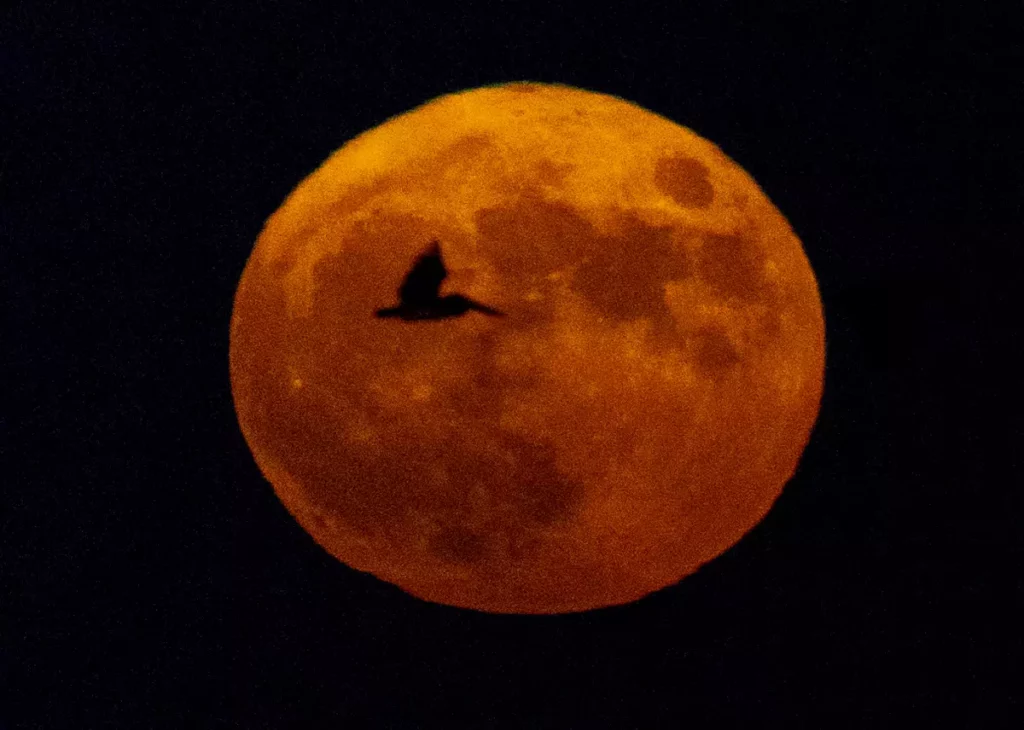A pelican glides against the backdrop of the super blue moon rising over Los Angeles Harbor, as observed from Cabrillo Beach in San Pedro, August 2023. The supermoon aligns with a blue moon, designated as the second full moon within a month.
The lunar cycle is about to showcase some of its most stunning views, starting August 19 and continuing with four consecutive months of supermoons — the brightest and largest full moons of the year.
“Typically, two or three supermoons occur annually, but four in a row is quite rare,” explained Tim Thompson, the science director at Mt. Wilson Observatory.
Supermoons happen when a full moon coincides with the moon’s closest point to Earth in its orbit, known as perigee. This makes the moon appear approximately 14% larger and 30% brighter than the faintest full moon of the year, according to NASA.
While some view this as a remarkable annual event, many experts define a supermoon as any full moon that is within 90% of its closest approach to the Earth, which is why multiple occurrences can take place in one year.
The supermoons in August and November will be about 224,000 miles from Earth, whereas those in September and October will be a bit closer at around 222,000 miles. Thompson referred to the latter as a “very near lunar perigee.”
October’s supermoon will be marginally closer than September’s, making it the most notable one, said Noah Petro, a lunar reconnaissance orbiter project scientist at NASA’s Goddard Space Flight Center. However, for casual observers, the differences among the four supermoons will be hard to notice.
“It’s a subtle distinction, but it’s an opportunity to engage interest in observation,” Petro commented. “It serves as a gateway for lunar enthusiasts.”
The four supermoons are scheduled for August 19, September 18, October 17, and November 15.
August’s full moon is particularly significant as it represents both a supermoon and a blue moon, the latter denoting a rare phenomenon of occurrence.
This supermoon qualifies as a blue moon not due to any color change but because it is the third full moon in a season with four, as stated by Petro. Additionally, a full moon is termed blue when it is the second full moon within a month, leading to two definitions—seasonal and monthly blue moons. This month’s event will be a seasonal blue supermoon.
There are no visual distinctions for a blue moon.
Petro encouraged observers not to fixate on precise dates, suggesting that any night is a good opportunity for moon gazing. He emphasized the joy of observing differences and appreciating the beauty of the moon.
“The lunar phases are cyclical,” he said. Astronomers also noted that the nights surrounding the supermoons will appear nearly full.
While supermoons have gained much attention in recent times, a rarer event known as the major lunar standstill is currently occurring. This phenomenon, which happens every 18.6 years, features the moon reaching the farthest points in its orbit, resulting in it rising and setting at its most northern and southern extremes during a span of about two years.
“It rises further south than the winter solstice sun,” said Vanessa Alarcon, an astronomical observer at Griffith Observatory. “It’s quite impressive to witness.”
The Griffith Observatory has specific markers on its lower West Terrace indicating the precise locations on the horizon for observing the major lunar standstill. However, anyone can observe this by watching the moon’s rise on the eastern horizon and set on the western horizon, with the best views during full moons. This phenomenon will continue well into 2025.
“Appreciating these occurrences is the ultimate aim,” Petro added. He emphasized that there are no ideal spots for viewing supermoons, and people shouldn’t feel disheartened if they miss the exact date or encounter poor weather.
“The lunar phases are recurring,” he stated. “So dust off your binoculars, dust off your telescopes, and make a memorable event of it.”
The International Observe the Moon Night is scheduled for September 14, just before the September supermoon.

